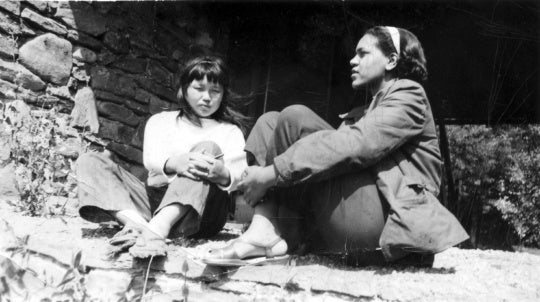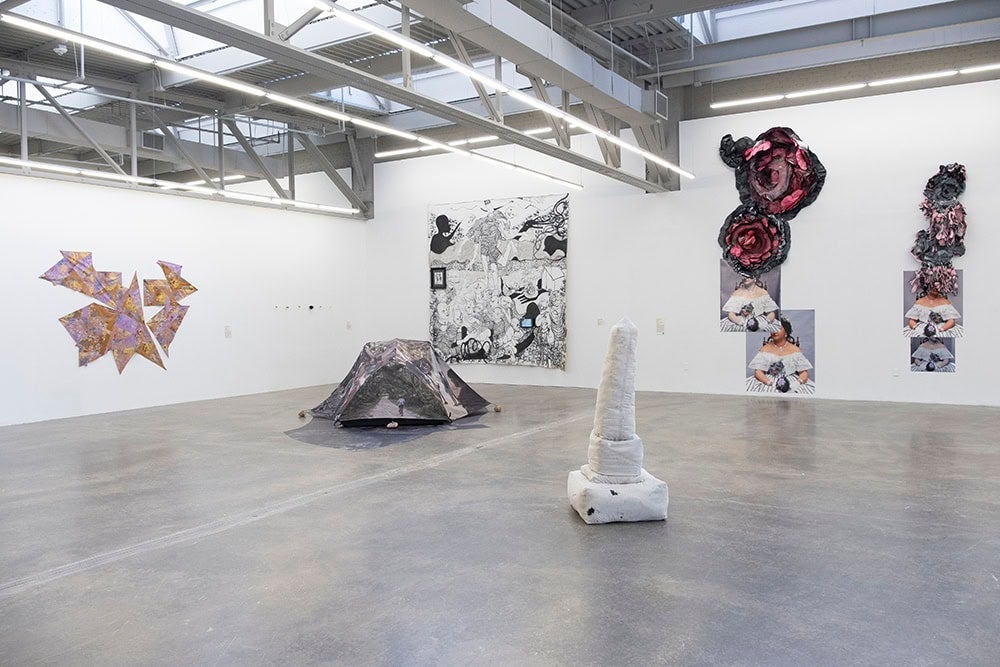
Shards of mirror and translucent glass glitter in the sunlight of the Atlanta Contemporary’s broad windows in Lillian Blades’ What is your reflection?. Located at the front of the galleries, it is one of the exhibition’s introductory works. It conjures up history—fragmented, elusive, but inextricably linked to the present—one of the big themes addressed in this year’s biennial.
Perhaps my favorite since its revival in 2016, this year’s biennial offers a cathartic account of contemporary art, centering both artists of color and the Atlanta region (19 of the 35 artists are from Georgia). The intersecting curatorial endeavor by Dr. Jordan Amirkhani and TK Smith consists of two parts: Amirkhani’s Of Care and Destruction and Smith’s Virtual Remains.
Flanking the main entrance are works by Shanequa Gay, Lillian Blades, and Artemus Jenkins. Gay’s bold silhouetted figures offer up new heroes from the artist’s expansive personal mythology. Part of Smith’s Virtual Remains, Jenkins draws on his practice of making memorial films, effectively eroding the distinction between documentary veracity and fiction in videos and installations that feature the eponymous character FREE WIFI.
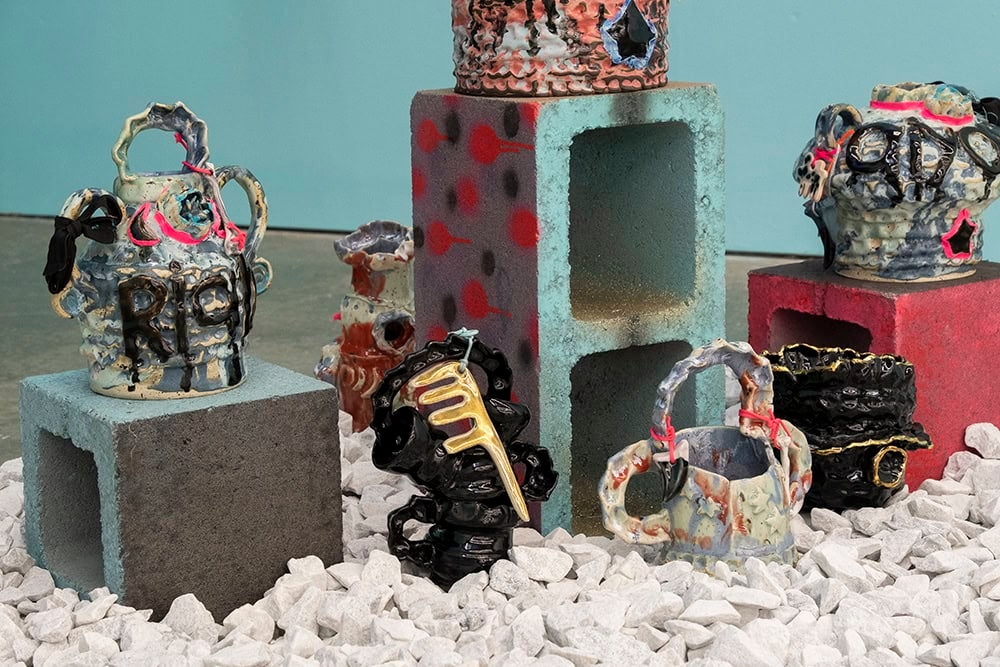
The front-and-center positioning of three Black Atlantan artists seems to be strategic curatorial staging: these are the artists—Southern, Black, two of them women—who have been historically marginalized from traditional art exhibition spaces. Next, a grouping of mostly black objects formally positions Blackness as one of the exhibition’s core concerns: crenellated Afrofuturist ceramic vessels by Donte K. Hayes; bulbous anti-form objects by Marianne Desmarais; a scribbled drawing that conjures moss and hair by Eleanor Neal; and, echoing Neal’s hirsute imagery, photographs that focus on Black women’s hair by Michelle Lisa Polissant.
The purposeful use of color continues with the pairing of two predominantly blue installations: LeAndra LeSeur’s There are other hues of blue and Courtney McClellan’s Professional Identity Formation. McClellan deftly deconstructs behaviors and ethics of the legal world, pairing a monoprint of blazer with references from a didactic text that discusses ethics and values of practicing lawyers.
A standout, LeSeur connects Blackness to blue in her six-channel video installation sourced from a Facebook Live feed by Sean Reed, who was killed by police in Indianapolis on March 7, 2020. Hanging screens show variations of blue that were lifted from the live-streamed recording of the fatal shooting of 21-year-old Reed, while a screen on the floor holds a single figure and shadow set against in sky blue. LeSeur speaks in a soft voice, creating a speculative monologue bisected by short passages of music. Poignantly, she asks: “What is death when life doesn’t hold value?” LeSeur’s murmuring voice is omnipresent, permeating the adjacent galleries.
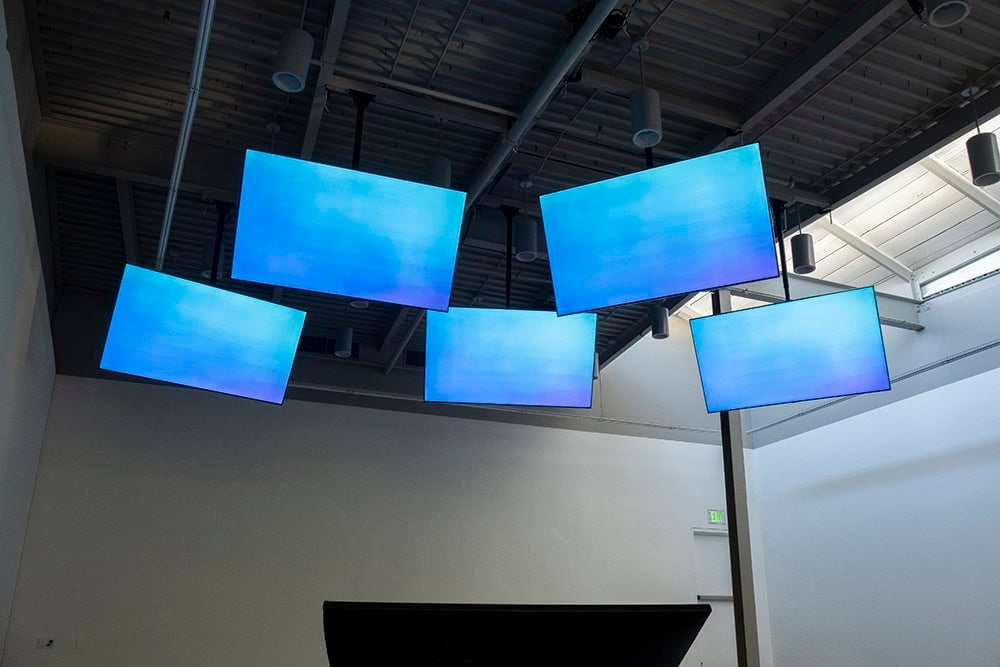
By its nature, the Atlanta Biennial necessitates consideration of Southern identity and history, inextricable from themes of racial oppression and white supremacy. It appears paramount in works like Melissa Vandenberg’s They Watch US Fall Apart, a small, fabric obelisk made of stained, stitched-together drop cloth that evokes the ongoing controversy surrounding confederate monuments. Vandenberg’s obelisk looks overpowered by the vibrant art around it. For example, a large colorful installation by Zipporah Camille Thompson’s features an assemblage of urn-like vessels that spell out names of Black women—one a girl of seven—who lost their lives in racist violence: Riah, Breonna, and Aiyani.
Yanique Norman’s multimedia Chytrid: Last Lady of the United States-Corregidora-Lincoln, LLOTUS (So they lie) and its counterpart, its title amended so to read (So I lie too), features intricate, proliferating cut-paper flowers that obscure the face of printed images Mary Todd Lincoln, whose name has been merged with that of a protagonist of Gayl Jones’ 1975 book, Corregidora, whose name traces back to a fictitious slave master . Norman’s re-imaged account of history is part of her notion of Black fungibility (in the artist’s words: “an alternate ideological dream model”). Just as LaSeur’s installation speaks to contemporary violence against Black bodies, Norman calls to mind its historical roots.
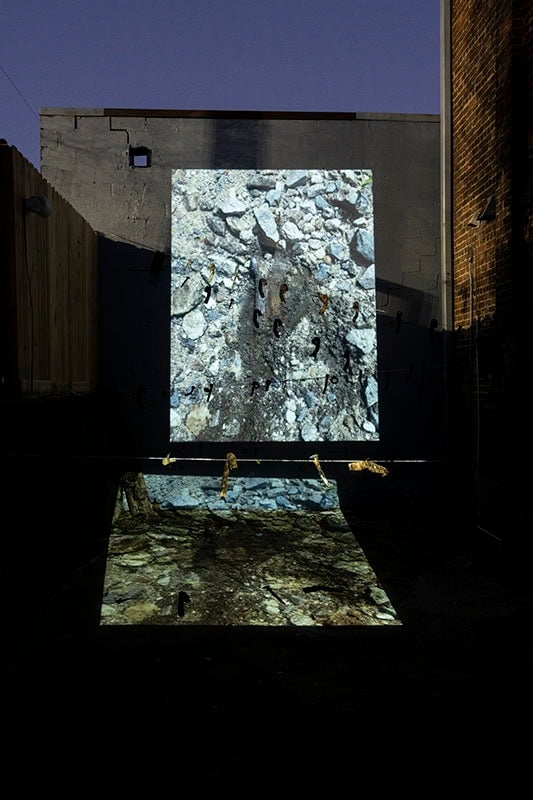
TK Smith’s Virtual Remains smartly takes advantage of the Contemporary’s peripheral Project Spaces—corners, outdoor, and basement venues ideal for installations that combine video and sculpture. In the subterranean Chute Space, Shane Dedman creates an homage to his own work destroyed while being stored in a basement. Two screens play synchronously: one showing damaged archival footage while the other loops Dedman’s narrative films that explore queer identity. It transforms from crepuscular to campily subversive, like an underground club.
Installations by Danielle Deadwyler and Adam Forrester deal most specifically with regional concerns, both exhuming fragmented bits of Georgia’s past. Adam Forrester’s exploration of the history of Phenix City, Alabama, in the narrow Sliver Space includes a short video, photographs, and copies of Xeroxed documents that reevaluates the small town’s 1950s reputation as “Sin City.” Danielle Deadwyler’s multimedia installation, FOR(E)RUNNER, features excavated objects—rusty remnants of the now defunct railroad tracks—hanging mutely in the sun, their russet hues and bone-like shapes evoking the absent bodies of the labors who used them. A soundtrack of minor-key music and railroad noises echoes in the Contemporary’s outdoor space, its own history as a warehouse quietly present. Like so much of the biennial work, the elegiac mood of Deadwyler’s work reflects the past year’s tragedies.
Ultimately, a small biennial presents a paradoxical situation: too much work for a tightly thematic account, too little work to capture the grandiosity of a global venue. But embrace the Atlanta Biennial for what it is, a regionally focused account of contemporary art that offers rich curatorial insight, and you might just experience some of the ameliorative potential of art—that is, care in its extensive form.



